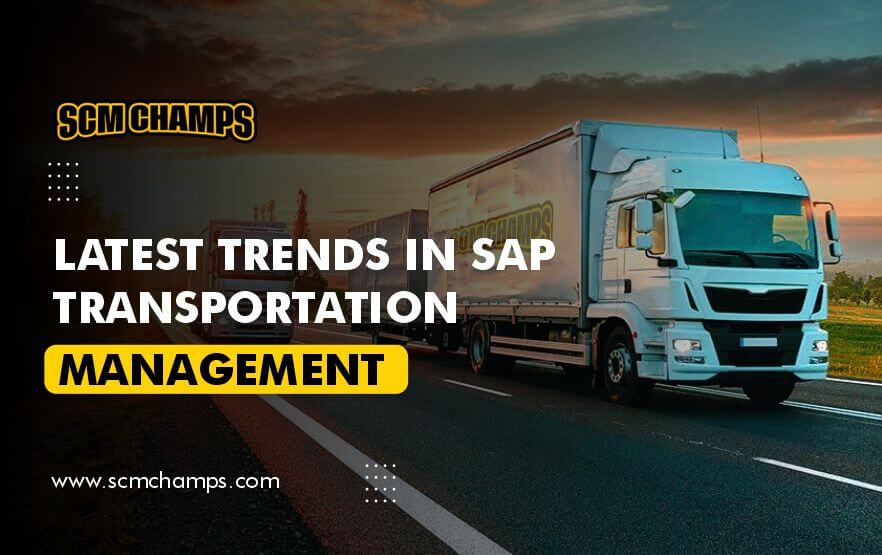
In today’s fast-paced business landscape, staying ahead of the curve is essential for successful supply chain management. With logistics and transportation playing a pivotal role, companies are turning to advanced solutions like SAP Transportation Management (SAP TM) to streamline their operations. Let’s explore the latest trends in SAP TM that are shaping the future of transportation management.
Latest trends in SAP Transportation Management
1. Increased Focus on Sustainability
Sustainability has become a top priority for businesses worldwide, and the transportation industry is no exception. Companies are leveraging SAP TM to optimize routes and reduce emissions, contributing to a greener supply chain. Sustainability features in SAP TM enable organizations to make environmentally responsible decisions while cutting costs.
2. Enhanced Visibility with IoT
The Internet of Things (IoT) is revolutionizing transportation management. By integrating IoT devices with SAP TM, companies gain real-time insights into the condition and location of their goods. This level of visibility enables proactive decision-making, reduces the risk of delays, and improves overall supply chain efficiency.
3. Predictive Analytics for Demand Forecasting
SAP TM is harnessing the power of predictive analytics to refine demand forecasting. By analyzing historical data, market trends, and other variables, SAP TM can provide accurate demand forecasts. This ensures that companies can optimize their transportation routes and resources in anticipation of future demand, reducing costs and improving customer satisfaction.
4. Artificial Intelligence (AI) and Machine Learning (ML) Integration
AI and ML are transforming transportation management by automating processes and enhancing decision-making. SAP TM is increasingly integrating AI and ML algorithms to optimize route planning, automate repetitive tasks, and provide data-driven insights. This not only reduces human error but also boosts overall efficiency.
5. Blockchain for Transparency and Security
Blockchain technology is being adopted in SAP TM to enhance transparency and security in supply chain transactions. It allows stakeholders to access immutable records of each shipment’s journey, reducing disputes and fraud. This trend is particularly significant in industries where traceability and authenticity are paramount.
6. Multi-Modal Transportation Solutions
The integration of multiple transportation modes in SAP TM is becoming more prevalent. Businesses are recognizing the importance of flexibility in their supply chain operations, and SAP TM is accommodating this by providing the tools to manage various modes of transportation seamlessly. This multi-modal approach enables companies to choose the most cost-effective and efficient transportation methods for each shipment.
7. Cloud-Based Solutions
Cloud-based SAP TM solutions are gaining popularity due to their scalability and cost-efficiency. Cloud deployments allow organizations to access the latest features and updates without the need for extensive on-premises infrastructure. This scalability ensures that businesses can adapt to changing transportation needs more easily.
8. Collaboration and Connectivity
Effective collaboration between all stakeholders in the supply chain is critical for success. SAP TM is evolving to provide enhanced collaboration features, allowing for better communication and coordination between shippers, carriers, and suppliers. Improved connectivity leads to smoother operations and reduced lead times.
9. Enhanced Customer Experience
The customer experience extends beyond the product itself and includes the delivery process. SAP TM is helping businesses enhance the customer experience by providing accurate tracking information, shorter delivery times, and improved communication. Meeting customer expectations for transparency and reliability can result in higher customer satisfaction and loyalty.
Conclusion
As businesses strive for greater efficiency and sustainability in their supply chain operations, SAP Transportation Management continues to evolve and adapt to these changing demands. By embracing the latest trends in SAP TM, organizations can optimize their transportation processes, reduce costs, and maintain a competitive edge in an ever-evolving marketplace. Whether it’s leveraging AI and IoT for real-time visibility or embracing sustainability practices, SAP TM remains a key driver of innovation in transportation management.


